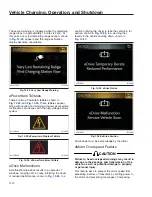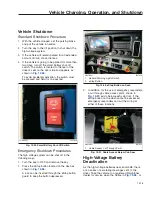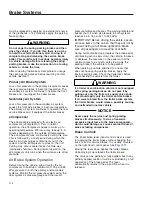
behavior, environmental temperature, and auxiliary
loads placed on the system.
If the vehicle load changes significantly, the
remaining range is recalculated with the new range
displaying within a minute.
•
A terrain of steep hills and valleys reduces the
vehicle range.
•
Extremely hot or extremely cold conditions
reduce the vehicle range. The vehicle is
equipped with a thermal battery system to
minimize loss of battery performance in both
cold and hot weather, but the energy draw to
heat and cool the batteries reduces the vehicle
range.
•
Running the cab heater or air conditioner, or
any other auxiliary power draw, reduces the
vehicle range.
Tips for Extending Vehicle Range
A driver can take a number of actions to extend the
range. These can be broken out into three areas: trip
preparation, driving style choices, and cab
environment decisions.
Trip preparation tips:
•
Allow the vehicle to fully precondition before
the trip.
•
Make sure the tires are properly inflated and
that all aerodynamic components are intact.
•
Position the fifth wheel as far forward as
possible without overloading the front axle.
Driving style choices:
•
Avoid rapid acceleration or deceleration when
possible.
•
Avoid using boost mode.
•
Avoid heavy usage of the friction brakes.
•
Use regenerative braking whenever possible.
Regenerative braking increases range by
charging the high-voltage batteries.
•
Lower the vehicle speed just before the crest
of a hill and regain the speed on the descent.
•
Set the regenerative braking lever to the
appropriate position (1-3) to maintain the
desired speed on downward grades.
•
Reduce the vehicle top speed.
•
Use economy or range mode when driving.
Range mode has the larger efficiency benefit.
•
Activate adaptive cruise control whenever
possible to maintain a steady speed.
Cab environment decisions:
•
Reduce heating and air conditioning usage.
Using heated seats consumes less energy
than heating the cab.
•
Keep the side windows closed.
Cold-Weather Operation
If the vehicle is in good mechanical condition and the
precautions necessary for cold-weather operation are
taken, ordinary cold weather should not cause
difficulty in starting the vehicle or loss of efficiency in
operating the vehicle.
The following points are important to observe when
operating in cold weather.
•
Check for cracks in the battery cases, for
corrosion of the terminals, and for tightness of
the cable clamps at the terminals.
f612041
04/15/2022
1
2
3
1.
High-Voltage Battery Status
2.
High-Voltage Battery State of Charge
3.
Projected Range on Current State of Charge
Fig. 10.15, Driver Display Speedometer
Vehicle Charging, Operation, and Shutdown
10.10
Содержание PX113064S T 2016
Страница 4: ......
Страница 10: ......
Страница 18: ......
Страница 57: ...f611343 09 28 2016 AIR SLIDE SLIDE LOCK Fig 4 18 Fifth Wheel Air Slide Dash Switch Driver Controls 4 8...
Страница 58: ......
Страница 83: ...6 Driver Assistance Features Electronic Stability Control ESC 6 1 PasSmart 6 1 SafetyDirect by Bendix 6 2...
Страница 86: ......
Страница 112: ......
Страница 122: ......
Страница 142: ......
Страница 154: ......
Страница 155: ...12 Steering System Power Steering System 12 1...
Страница 158: ......
Страница 159: ...13 eAxle eAxle 2 Speed Transmission 13 1...
Страница 176: ......
Страница 190: ......
Страница 202: ......
Страница 222: ......
Страница 223: ...20 Emissions Information Noise Emissions 20 1 Greenhouse Gas Emissions 20 1...
Страница 229: ......
Страница 236: ......








































